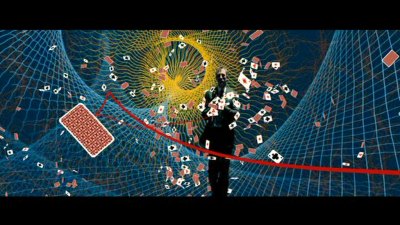
The relationship between Bond and Vesper is accorded a few minutes. While we are told they are mad for each other, little of the emotional or physical chemistry that would convince us makes its way to the screen…
In the end, this is what makes a “realistic” Bond an oxymoron. Insofar as a Bond film comes into contact with social and historical facts, it must turn them on their head, losing any of its charm in the process.
Aside from a few entertaining and adventurous moments, and the lovely settings, there is very little to Casino Royale.
And what there is, disturbs.
Casino Royale: the new James Bond film
By David Walsh
8 December 2006Casino Royale, directed by Martin Campbell, screenplay by
Neal Purvis, Robert Wade and Paul Haggis, based on the
novel by Ian FlemingThe James Bond films have been with us for more than 40
years, for better or worse. They are not so much a barometer
of popular moods but of the thinking of a layer of mercenary
film studio executives attempting to gauge or guess at
popular moods.Ian Fleming (1908-1964), who wrote the books on which the
films were initially based, was a fairly unsavory character.
The son of a Conservative Member of Parliament who died
during World War I, Fleming worked for British naval
intelligence in the Second World War and used some of this
experience for his Bond novels. The first one, Casino Royale,
appeared in 1953.As numerous commentators have pointed out, James Bond’s
rise as a fantasy secret agent coincided with Britain’s actual
decline as a world power during the postwar era. In Fleming’
s fiction, however, the cool and collected Briton outthought,
outfought and outloved not only his Soviet opponents, but
also his American “allies.”The Bond novels were vaguely risqué in their time (Fleming’s
wife called them “Ian’s pornography”), with hints of unusual
sexual activity. Many adolescent boys were drawn to them in
the less permissive atmosphere of the early 1960s. A number
of the female characters are lesbians and have to be returned
to “normalcy” by Bond. The relationships are generally of the
dominator-dominated variety. In The Spy Who Loved Me,
Fleming’s narrator, a woman, explains: “All women love semi-
rape. They love to be taken. It was his sweet brutality
against my bruised body that made his act of love so
piercingly wonderful. That and the coinciding of nerves so
completely relaxed after the removal of tension and danger,
the warmth of gratitude, and a woman’s natural feeling.” Ayn
Rand was a big admirer, unsurprisingly.Umberto Eco, in a 1979 work, pointed to a number of binary
oppositions that defined the Bond novels: positive values and
features (Free World, Great Britain, Western civilization,
sacrifice, duty, willingness to undergo pain, loyalty, physical
attractiveness) associated with the secret agent and negative
ones (Soviet Union, foreignness, physical deformity, luxury,
excess, perversion, disloyalty) attached to the enemy. Eco
commented: “Bond represents beauty and virility as opposed
to the Villain, who often appears monstrous and sexually
impotent.” Racism and national chauvinism abound in
Fleming, along with other unpleasant attitudes.There have been 21 “official” Bond films directed by nine
different, mostly British and mostly unremarkable
filmmakers; another was born in Canada, but raised in
England (Roger Spottiswoode); and two more come from
New Zealand (Lee Tamahori, who has a Maori father and
British mother, and Martin Campbell, the director of the
current film). In his The American Cinema, Andrew Sarris
noted that Terence Young (Dr. No, From Russia With Love,
Thunderball) had done “the best of the Bonds,” but that his
overall career was “staggeringly undistinguished.” The
individual, John Glen, who directed the most Bond films
(five), oddly enough, hardly made anything else.It would be a mistake to become overly nostalgic about the
early films. Even at the time, they were compared
unfavorably to other efforts in the spy genre. Sarris, for
example, in 1965, contrasted Sean Connery, the first Bond, to
Michael Caine in Sidney Furie’s The Ipcress File. He wrote
that Caine was “a more attractive performer” than Connery
and suggested that Caine’s character was “more comically
accessible to audiences than Connery’s. Caine’s success with
women is more plausible than that of his predecessor largely
because Caine’s banter sounds more knowing. Connery’s
conquests seem to reflect the triumph of wardrobe over wit,
and his women almost invariably succumb with the
spontaneity of mechanical dolls in some future interplanetary
convention of department-store buyers.”In Dr. No, Joseph Wiseman as the villain and Ursula Andress,
as the love interest, stand out; in Goldfinger, one remembers
the German actor Gert Fröbe and Honor Blackman. Connery
had some suave and sophisticated moments. A great deal of
the rest is silence. In recent decades, the series has more or
less turned into a parody of itself, sometimes deliberately, as
the special effects and weaponry have pushed everything
else into the background.Fleming’s Casino Royale is an implausible Cold War tale. In
the novel, Le Chiffre is a French Communist and agent for the
Soviet assassination bureau SMERSH, who is presiding over a
baccarat game in Monte Carlo in an effort to raise the 50
million francs in KGB funds he lost running a string of
brothels! Bond, the best card player in the British secret
service, is assigned to play Le Chiffre and beat him, thus
provoking his employers to murder him. Bond is assisted by
Vesper Lynd, with whom he falls madly in love, as well as an
American CIA agent. Betrayals and double-crosses lie in
store for 007.In the new film, the first version of Fleming’s Casino Royale
(the 1967 film, with David Niven and a host of others, was a
spoof), Bond (Daniel Craig) has only recently gained his
“license to kill,” by murdering his second victim (whose
violent death in a public bathroom we witness during the pre-
credits). Then, inexplicably, Bond is on the trail of a
bombmaker in Madagascar. An extended chase ensues,
followed by an explosion. Contrary to instructions, Bond
heads for the Bahamas and eventually Miami, where he foils a
plot to blow up a new jetliner.Meanwhile, Le Chiffre (Danish actor Mads Mikkelsen), who,
naturally, is a banker for “terrorists” in Campbell’s film, has
invested $100 million for an African terrorist on the
assumption that the jetliner will be blown up and its
manufacturer ruined. Now his angry clients want their money
back, and he plans to win it back playing baccarat at a casino
in Montenegro. Bond is supplied with $10 million of the
British government’s money, and an assistant, Vesper Lynd
(Eva Green), in an effort to foil him.If Bond films indicate something about the mood of those
who commission, organize and shoot them (and perhaps
wider circles than that), what does Casino Royale tell us? At
the time of Daniel Craig’s hiring as Bond (following Connery,
Roger Moore, George Lazenby, Timothy Dalton and Pierce
Brosnan), director Campbell promised something “definitely
darker, more character, less gadgets.”There are fewer weapons and explosions in Campbell’s work
(although the lengthy chase scenes are tedious), and the
mood is definitely more somber. The film is oddly spasmodic,
fragmented and without any real center, geographical or
moral. The headquarters of Bond’s agency, which played a
considerable and reassuring role in many of the early films, is
gone, replaced by an anonymous apartment (belonging to M
[Judi Dench], Bond’s boss) in London’s Canary Wharf
district. The villains are not “terrorists” in any meaningful
political sense—in fact, it’s entirely unclear who and what
they are. The leading participants in the events of the film’s
last few minutes are virtually unknown to us, and die or
disappear before they make their presence felt dramatically.The tone and rhythm of Casino Royale are deeply
inconsistent. Not certain in which direction to proceed, the
filmmakers, one senses, try various approaches. Scenes of
genuinely sadistic, “realistic” violence alternate with idyllic
sequences set in the Bahamas, Italy’s Lake Como, Venice and
various locales in the Czech Republic (which for some reason
stands in for Montenegro) and efforts at creating “character.”The relationship between Bond and Vesper is accorded a few
minutes. While we are told they are mad for each other, little
of the emotional or physical chemistry that would convince
us makes its way to the screen. And Green and Craig are
burdened, more or less out of the blue, with lines like this:
“If the only thing left of you was your smile and your little
finger, you’d still be more of a man than anyone I’ve ever
met” and “I have no armour left. You’ve stripped it from me.
Whatever is left of me—whatever I am—I’m yours.”Aside from a few moments reclining with Vesper, Bond here
is oddly machine-like, almost robotic. He moves rapidly,
hurling himself from one point to the next. Connery’s Bond
had some of the swaggering, almost lazy self-assurance of
the Cold War “democracies”; Crag is nervous, unhappy,
isolated. Some of this feels appropriate to the historical
moment, but the psychological changes in the character have
not been worked through; they seem to have evolved more
or less arbitrarily and accidentally.The sadistic violence is troubling. Here too the filmmakers,
albeit unconsciously, are attuned to the “dark” and frustrated
moods of certain social layers. The film opens with Bond
beating a man half to death and nearly concludes with his
own brutal torture. The early Bond films, including their fight
scenes, were utterly unreal and artificial, quasi-comical. In
essence, very little of that unreality has been addressed in
the new Casino Royale (the politics are far more skewed and
fanciful, in fact), except in the increased intensity and
duration of the violence. Whereas events, including the love
story, generally proceed rather quickly, the filmmakers slow
down to devote a considerable amount of time, lovingly, to
the torture scene in particular, during which Bond is strapped
naked to a chair. There is nothing healthy in that.It is especially ironic that the “terrorists,” or at least their
agent, should be carrying out acts of sexual torture. As we
know, the American and British military and intelligence
forces, and their allies, are the leading experts in this field.
In the end, this is what makes a “realistic” Bond an
oxymoron. Insofar as a Bond film comes into contact with
social and historical facts, it must turn them on their head,
losing any of its charm in the process.Aside from a few entertaining and adventurous moments,
and the lovely settings, there is very little to Casino Royale.
And what there is, disturbs.



